International Financial Management: Analyzing FDI in the United States
VerifiedAdded on 2023/06/13
|5
|869
|345
Report
AI Summary
This report critically evaluates the rationale behind foreign direct investment (FDI) in the United States, highlighting its position as the largest recipient of FDI globally. It discusses the attractive investment climate factors, including a large consumer market, predictable regulatory environment, and innovative sectors. The report analyzes the financing of FDI by parent companies through equity capital, intercompany debt, and reinvested earnings, referencing data on the composition of financial sources. It further explores the reasons behind firms investing in the US, citing special managerial abilities, product knowledge, and competitive advantages. The document concludes by referencing works that support the analysis of international financial management and FDI in the United States. Desklib offers more resources for students.
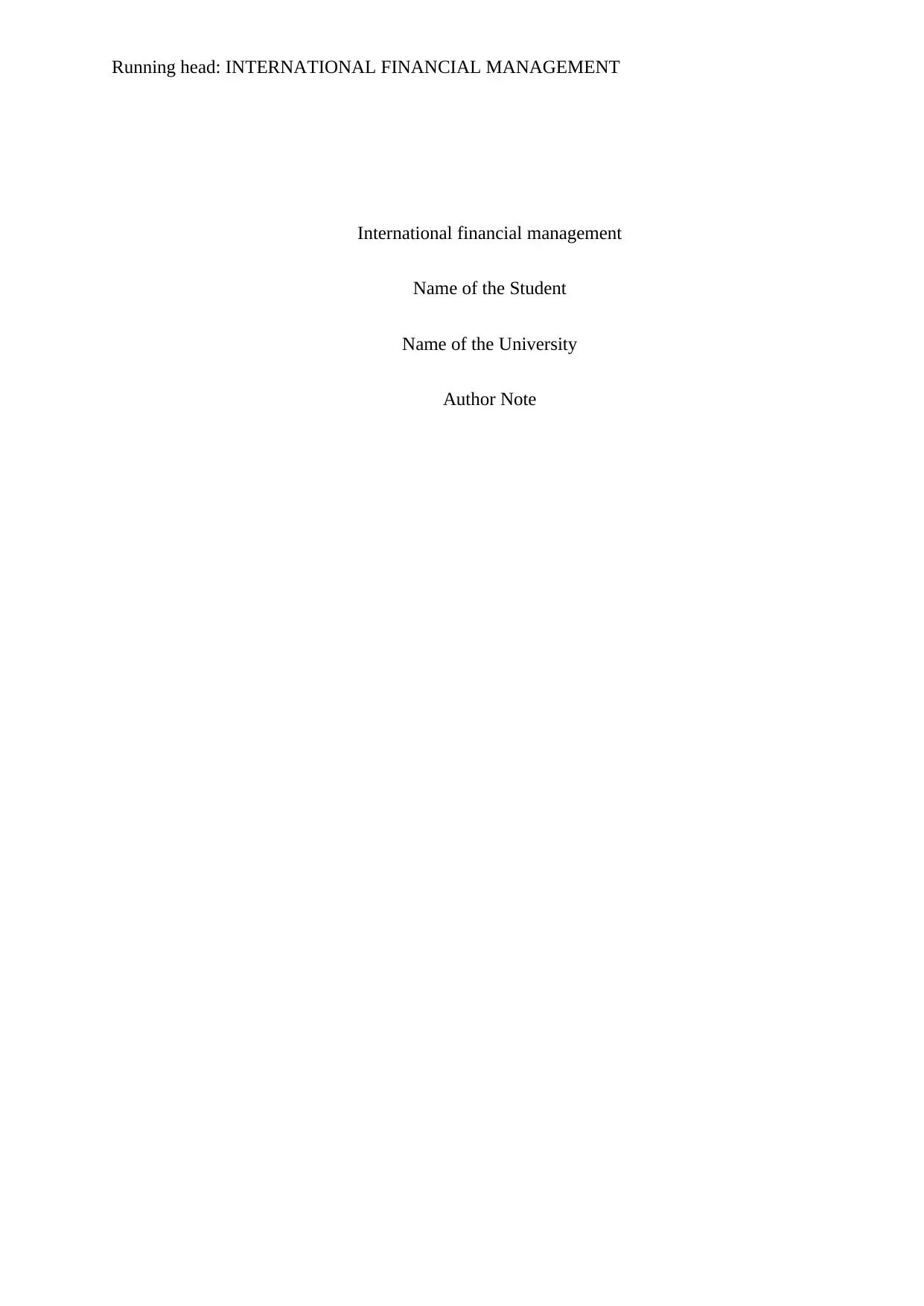
Running head: INTERNATIONAL FINANCIAL MANAGEMENT
International financial management
Name of the Student
Name of the University
Author Note
International financial management
Name of the Student
Name of the University
Author Note
Paraphrase This Document
Need a fresh take? Get an instant paraphrase of this document with our AI Paraphraser
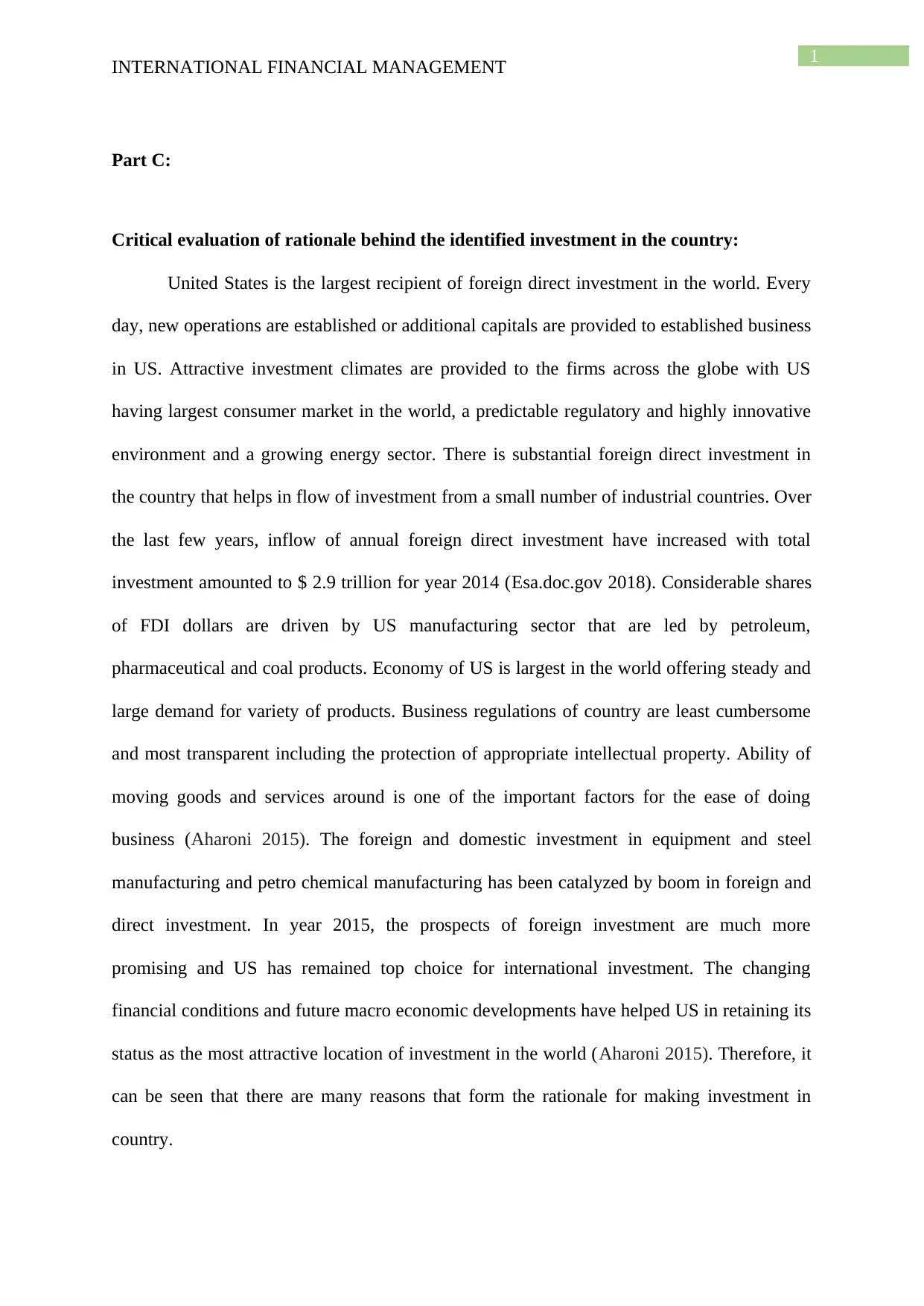
1
INTERNATIONAL FINANCIAL MANAGEMENT
Part C:
Critical evaluation of rationale behind the identified investment in the country:
United States is the largest recipient of foreign direct investment in the world. Every
day, new operations are established or additional capitals are provided to established business
in US. Attractive investment climates are provided to the firms across the globe with US
having largest consumer market in the world, a predictable regulatory and highly innovative
environment and a growing energy sector. There is substantial foreign direct investment in
the country that helps in flow of investment from a small number of industrial countries. Over
the last few years, inflow of annual foreign direct investment have increased with total
investment amounted to $ 2.9 trillion for year 2014 (Esa.doc.gov 2018). Considerable shares
of FDI dollars are driven by US manufacturing sector that are led by petroleum,
pharmaceutical and coal products. Economy of US is largest in the world offering steady and
large demand for variety of products. Business regulations of country are least cumbersome
and most transparent including the protection of appropriate intellectual property. Ability of
moving goods and services around is one of the important factors for the ease of doing
business (Aharoni 2015). The foreign and domestic investment in equipment and steel
manufacturing and petro chemical manufacturing has been catalyzed by boom in foreign and
direct investment. In year 2015, the prospects of foreign investment are much more
promising and US has remained top choice for international investment. The changing
financial conditions and future macro economic developments have helped US in retaining its
status as the most attractive location of investment in the world (Aharoni 2015). Therefore, it
can be seen that there are many reasons that form the rationale for making investment in
country.
INTERNATIONAL FINANCIAL MANAGEMENT
Part C:
Critical evaluation of rationale behind the identified investment in the country:
United States is the largest recipient of foreign direct investment in the world. Every
day, new operations are established or additional capitals are provided to established business
in US. Attractive investment climates are provided to the firms across the globe with US
having largest consumer market in the world, a predictable regulatory and highly innovative
environment and a growing energy sector. There is substantial foreign direct investment in
the country that helps in flow of investment from a small number of industrial countries. Over
the last few years, inflow of annual foreign direct investment have increased with total
investment amounted to $ 2.9 trillion for year 2014 (Esa.doc.gov 2018). Considerable shares
of FDI dollars are driven by US manufacturing sector that are led by petroleum,
pharmaceutical and coal products. Economy of US is largest in the world offering steady and
large demand for variety of products. Business regulations of country are least cumbersome
and most transparent including the protection of appropriate intellectual property. Ability of
moving goods and services around is one of the important factors for the ease of doing
business (Aharoni 2015). The foreign and domestic investment in equipment and steel
manufacturing and petro chemical manufacturing has been catalyzed by boom in foreign and
direct investment. In year 2015, the prospects of foreign investment are much more
promising and US has remained top choice for international investment. The changing
financial conditions and future macro economic developments have helped US in retaining its
status as the most attractive location of investment in the world (Aharoni 2015). Therefore, it
can be seen that there are many reasons that form the rationale for making investment in
country.
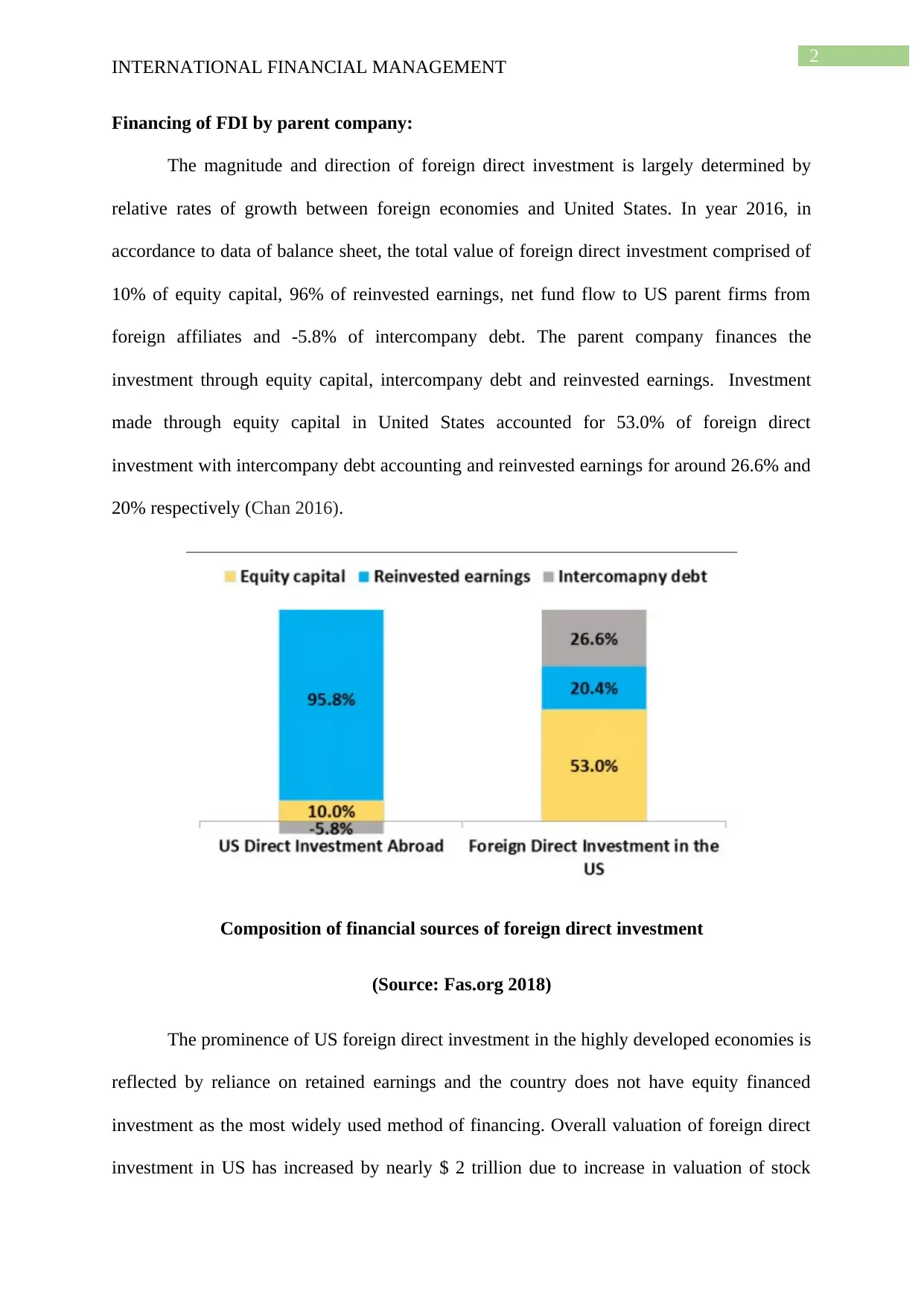
2
INTERNATIONAL FINANCIAL MANAGEMENT
Financing of FDI by parent company:
The magnitude and direction of foreign direct investment is largely determined by
relative rates of growth between foreign economies and United States. In year 2016, in
accordance to data of balance sheet, the total value of foreign direct investment comprised of
10% of equity capital, 96% of reinvested earnings, net fund flow to US parent firms from
foreign affiliates and -5.8% of intercompany debt. The parent company finances the
investment through equity capital, intercompany debt and reinvested earnings. Investment
made through equity capital in United States accounted for 53.0% of foreign direct
investment with intercompany debt accounting and reinvested earnings for around 26.6% and
20% respectively (Chan 2016).
Composition of financial sources of foreign direct investment
(Source: Fas.org 2018)
The prominence of US foreign direct investment in the highly developed economies is
reflected by reliance on retained earnings and the country does not have equity financed
investment as the most widely used method of financing. Overall valuation of foreign direct
investment in US has increased by nearly $ 2 trillion due to increase in valuation of stock
INTERNATIONAL FINANCIAL MANAGEMENT
Financing of FDI by parent company:
The magnitude and direction of foreign direct investment is largely determined by
relative rates of growth between foreign economies and United States. In year 2016, in
accordance to data of balance sheet, the total value of foreign direct investment comprised of
10% of equity capital, 96% of reinvested earnings, net fund flow to US parent firms from
foreign affiliates and -5.8% of intercompany debt. The parent company finances the
investment through equity capital, intercompany debt and reinvested earnings. Investment
made through equity capital in United States accounted for 53.0% of foreign direct
investment with intercompany debt accounting and reinvested earnings for around 26.6% and
20% respectively (Chan 2016).
Composition of financial sources of foreign direct investment
(Source: Fas.org 2018)
The prominence of US foreign direct investment in the highly developed economies is
reflected by reliance on retained earnings and the country does not have equity financed
investment as the most widely used method of financing. Overall valuation of foreign direct
investment in US has increased by nearly $ 2 trillion due to increase in valuation of stock
⊘ This is a preview!⊘
Do you want full access?
Subscribe today to unlock all pages.

Trusted by 1+ million students worldwide
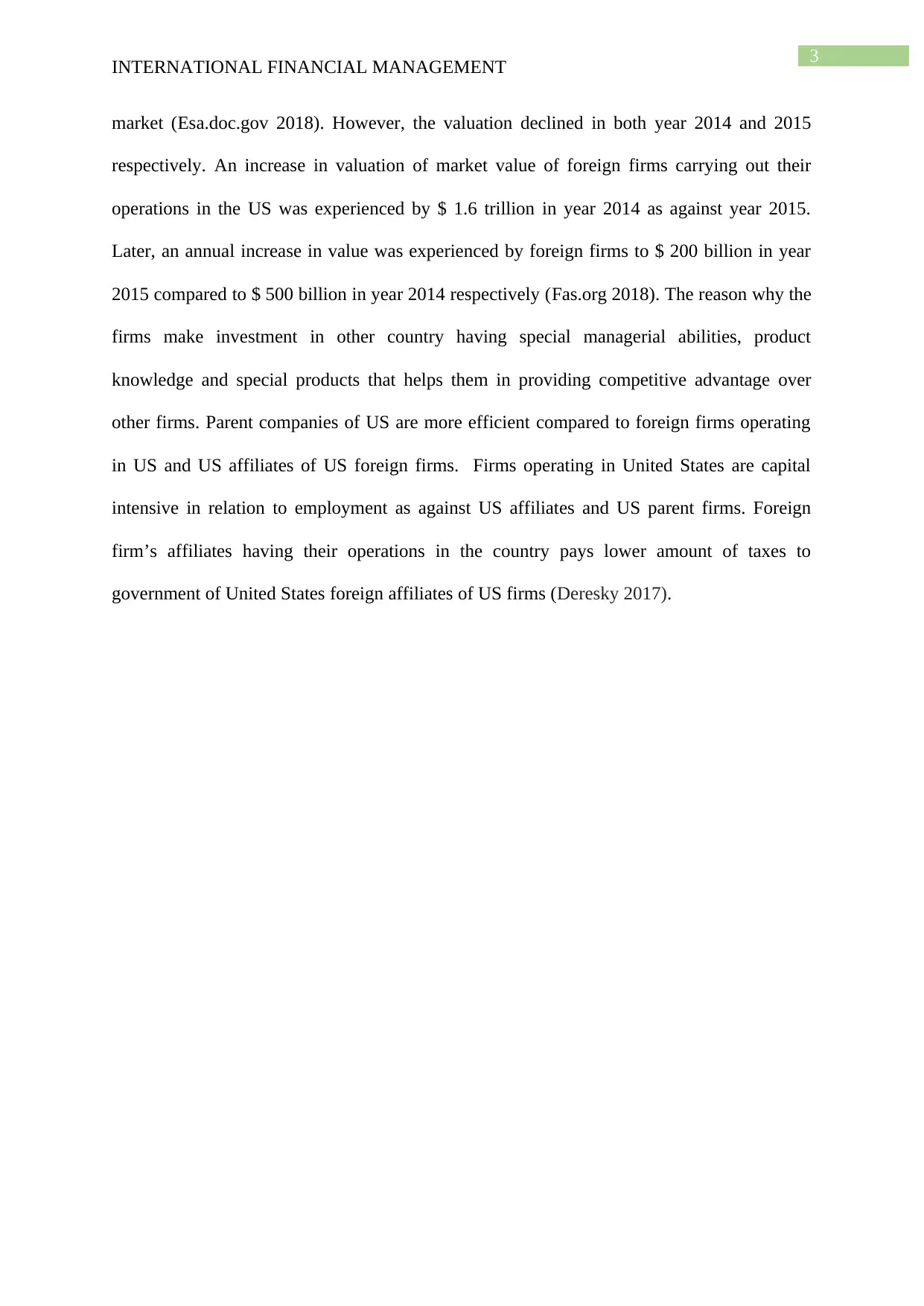
3
INTERNATIONAL FINANCIAL MANAGEMENT
market (Esa.doc.gov 2018). However, the valuation declined in both year 2014 and 2015
respectively. An increase in valuation of market value of foreign firms carrying out their
operations in the US was experienced by $ 1.6 trillion in year 2014 as against year 2015.
Later, an annual increase in value was experienced by foreign firms to $ 200 billion in year
2015 compared to $ 500 billion in year 2014 respectively (Fas.org 2018). The reason why the
firms make investment in other country having special managerial abilities, product
knowledge and special products that helps them in providing competitive advantage over
other firms. Parent companies of US are more efficient compared to foreign firms operating
in US and US affiliates of US foreign firms. Firms operating in United States are capital
intensive in relation to employment as against US affiliates and US parent firms. Foreign
firm’s affiliates having their operations in the country pays lower amount of taxes to
government of United States foreign affiliates of US firms (Deresky 2017).
INTERNATIONAL FINANCIAL MANAGEMENT
market (Esa.doc.gov 2018). However, the valuation declined in both year 2014 and 2015
respectively. An increase in valuation of market value of foreign firms carrying out their
operations in the US was experienced by $ 1.6 trillion in year 2014 as against year 2015.
Later, an annual increase in value was experienced by foreign firms to $ 200 billion in year
2015 compared to $ 500 billion in year 2014 respectively (Fas.org 2018). The reason why the
firms make investment in other country having special managerial abilities, product
knowledge and special products that helps them in providing competitive advantage over
other firms. Parent companies of US are more efficient compared to foreign firms operating
in US and US affiliates of US foreign firms. Firms operating in United States are capital
intensive in relation to employment as against US affiliates and US parent firms. Foreign
firm’s affiliates having their operations in the country pays lower amount of taxes to
government of United States foreign affiliates of US firms (Deresky 2017).
Paraphrase This Document
Need a fresh take? Get an instant paraphrase of this document with our AI Paraphraser
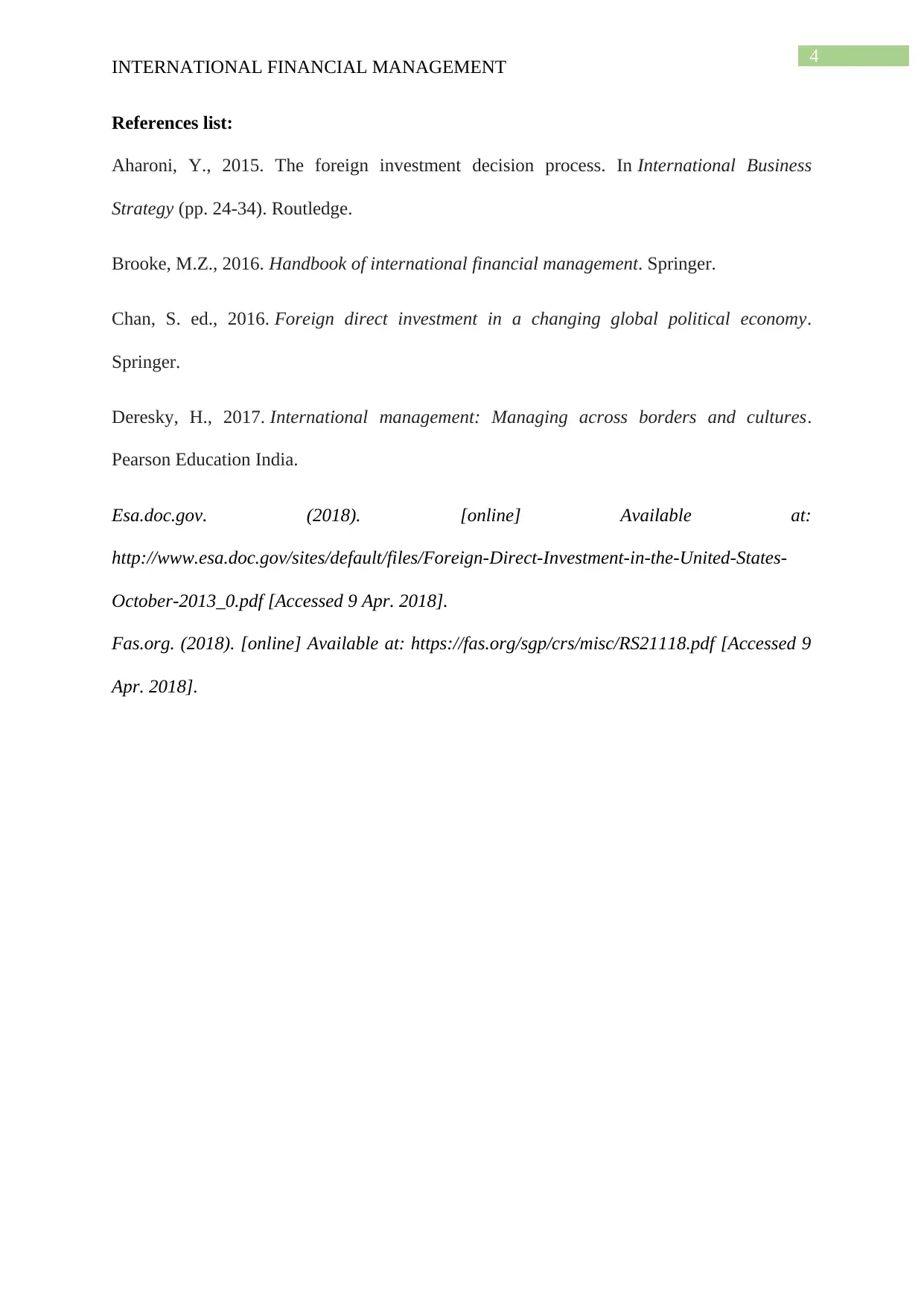
4
INTERNATIONAL FINANCIAL MANAGEMENT
References list:
Aharoni, Y., 2015. The foreign investment decision process. In International Business
Strategy (pp. 24-34). Routledge.
Brooke, M.Z., 2016. Handbook of international financial management. Springer.
Chan, S. ed., 2016. Foreign direct investment in a changing global political economy.
Springer.
Deresky, H., 2017. International management: Managing across borders and cultures.
Pearson Education India.
Esa.doc.gov. (2018). [online] Available at:
http://www.esa.doc.gov/sites/default/files/Foreign-Direct-Investment-in-the-United-States-
October-2013_0.pdf [Accessed 9 Apr. 2018].
Fas.org. (2018). [online] Available at: https://fas.org/sgp/crs/misc/RS21118.pdf [Accessed 9
Apr. 2018].
INTERNATIONAL FINANCIAL MANAGEMENT
References list:
Aharoni, Y., 2015. The foreign investment decision process. In International Business
Strategy (pp. 24-34). Routledge.
Brooke, M.Z., 2016. Handbook of international financial management. Springer.
Chan, S. ed., 2016. Foreign direct investment in a changing global political economy.
Springer.
Deresky, H., 2017. International management: Managing across borders and cultures.
Pearson Education India.
Esa.doc.gov. (2018). [online] Available at:
http://www.esa.doc.gov/sites/default/files/Foreign-Direct-Investment-in-the-United-States-
October-2013_0.pdf [Accessed 9 Apr. 2018].
Fas.org. (2018). [online] Available at: https://fas.org/sgp/crs/misc/RS21118.pdf [Accessed 9
Apr. 2018].
1 out of 5
Related Documents
Your All-in-One AI-Powered Toolkit for Academic Success.
+13062052269
info@desklib.com
Available 24*7 on WhatsApp / Email
![[object Object]](/_next/static/media/star-bottom.7253800d.svg)
Unlock your academic potential
Copyright © 2020–2025 A2Z Services. All Rights Reserved. Developed and managed by ZUCOL.





